Planning And Persistence Saves Historical Asset For Community Revitalization
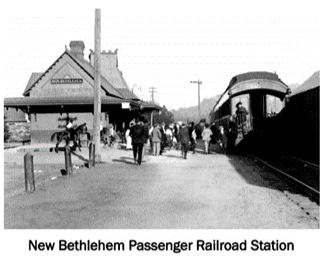
New Bethlehem, situated in an area rich in natural resources, became a business center in the 1800’s.Lumbering was the first industry, followed by mining of coal, iron, limestone, clay, gas and oil. Businesses sprang up in town including a lumber mill, distillery, brewery, dairy, restaurants, shops, and factories that made pottery, glass, tile and cigars. Hotels, a theater and even an opera house opened. The Allegheny Valley Rail Road’s Low Grade Corridor, built in 1873-1876, ran through town along Redbank Creek on its route between the Allegheny River through Brookville to Driftwood to transport raw materials, finished goods and passengers.
By the 1940’s passenger train service stopped, but the town prospered through the 1950’s. By the early 2000’s mining resources were being depleted, many businesses had closed as malls took business elsewhere, employment was declining, and freight trains stopped running. The once prosperous town had lost some of its luster.
In 2006, a group of concerned citizens formed Redbank Renaissance (Renaissance) to address community revitalization by filling buildings with businesses and improving the town’s appearance. Renaissance members started attending downtown revitalization workshops put on by the Pennsylvania Downtown Center and used the Main Street Four Point Approach of Economic Vitality, Design, Promotion and Organization as the structure for their work.
“It wasn’t until 2007 when the local railroad tracks through the Valley were lifted that it hit us,” said local historian Don Shilling. “A very vital part of history was leaving town… the railroad that had supported the Valley for 134 years was now gone.”
“We learned the owners of the railroad needed to find a new owner, or they would have to abandon the corridor, which meant it would be divided up and revert to adjoining landowners – not available for public use,” explained Sandy Mateer, President of Renaissance, Redbank Valley Trails Association (RVTA) and a New Bethlehem Borough Council Member. “The community wanted a trail, but some of the adjoining property owners didn’t.”
Renaissance was a very small group with limited resources, but lots of determination. They knew they had much to learn about trail development, needed the help of partners, and needed a plan. Renaissance partnered with New Bethlehem Borough, State legislators, Pennsylvania Department of Conservation & Natural Resources (DCNR), Allegheny Valley Land Trust, and community volunteers to save the rail corridor that spans 51 miles in Jefferson and Clarion Counties.
Renaissance and the Jefferson County Development Department asked County Commissioners and the planning departments from both counties for assistance in planning the trail, and got the trail concept included into the Jefferson County Greenway Plan and the Clarion County Greenway Plan. The Allegheny Valley Land Trust (AVLT), developer of the nearby Armstrong Trail, began discussions with the railroad owner and adjoining property owners and guided volunteers through the necessary steps. Through dialogue and public input meetings they were able to address concerns of some of the major landowners, the railroad and the community.
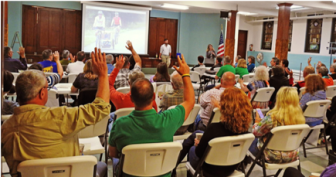
“A railbanking and sales agreement was executed between the railroad company and AVLT allowing the out-of-service rail corridor to be used as a trail until the railroad might need the corridor again for rail service,” explained Mateer. “AVLT did not want to hold the corridor permanently, so we formed the Redbank Valley Trails Association (RVTA) to take ownership of the corridor and build the trail. We asked landowners, trail supporters and borough council members from the towns along the corridor to serve on the new RVTA Board, because it was important for them to be heard and invested in the project.”
RVTA members began attending conferences on trail planning and development put on by DCNR, Pennsylvania Parks and Recreation Society, PA Wilds and others. “We learned a lot from the presentations and by talking with other people that were building trails,” said Mateer. “The conferences were great places to network, get ideas and get inspired. We learned about available grants and their requirements. This was critical for our understanding that we needed more than a trail concept, we needed a formal trail plan in order to get funding. So, we asked New Bethlehem Borough to apply for planning grants.”
The Borough secured grants from the Northwest Commission Greenways Block Grant Program and DCNR for the New Bethlehem Trail Town Study. Another grant was secured for a Trail Feasibility Planning Study. Both studies were conducted concurrently. To encourage regional collaboration, Renaissance invited other communities along the trail to participate in the studies.
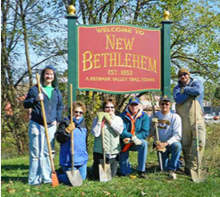
“We used examples from other trails in the planning meetings to garner community support,” said Mateer.“Our speakers talked about the benefits of trails. Flip charts, maps of downtown, and trail segment maps of the whole trail corridor were used to gather input on issues, and where improvements were needed.”
While planning was ongoing, trail building began using local resources. One of the property owners and a dedicated RVTA Board Member, Darla Kirkpatrick, had access to equipment from Rosebud Mining. She organized volunteers to clear and grade sections of the trail. Work started out from and near boroughs which helped create connections to get local people on the open sections of trail and build local support. Volunteers put decking and railings on bridges to expand the length of usable trail. Volunteers designed the trail website, maps, and signage. Scouts, students and volunteers did clean-up events and maintenance.
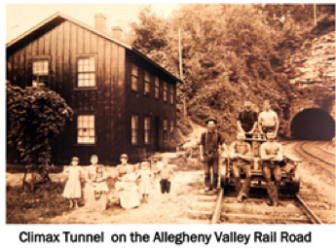
Board members and community members helped with the fundraising. Naming rights for bridges were offered to private donors. Local funds, in-kind labor and the plans that had been created were used to secure grant funds to build the more technically challenging parts of the trail. By 2016 most of the 51-mile trail had been constructed, but major money was needed to repair the Climax Tunnel. The tunnel became one of DCNR’s Top Ten Trail Gaps in the state.
“We worked with our partners to secure grants from PennDOT, DCNR and the Commonwealth Financing Authority, to get the $2.3 million needed to restore the tunnel,” said Mateer. “The Climax Tunnel was completed in August 2018 and the entire 42 miles of the main Redbank Valley Trail was open. It was the first Top Ten Trail Gap in Pennsylvania to be completed. Soon we will complete the remaining 9 miles of the Sligo Spur, and the entire trail will be complete.”
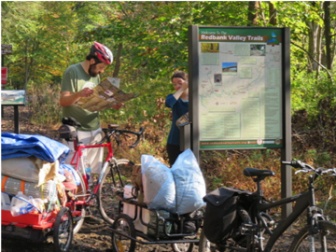
Renaissance and RVTA continue to make improvements and leverage the trail for community revitalization. Trail use by local residents and visitors is growing. Six new businesses have opened — two restaurants and four B & B’s/guest houses. Community revitalization efforts continue through quarterly Towns & Trails meetings along the Redbank Valley and Armstrong Trails
“It’s gratifying to see kids, families, schools and church groups using the trail,” said Mateer. “The trail energizes the community and brings people together. You never see an unhappy person on the trail.”
Lessons Learned:
- Even a small group can complete a large project if they are determined, persistent and work collaboratively with like-minded groups.
- Regional coalitions can benefit multiple communities.
- Planning is paramount to achieving your goals and securing funding support for projects.
- Involve all stakeholders in the planning process and ensure that everyone’s concerns are heard and addressed.
- Attend educational conferences to learn from speakers, network with peers and funders.

